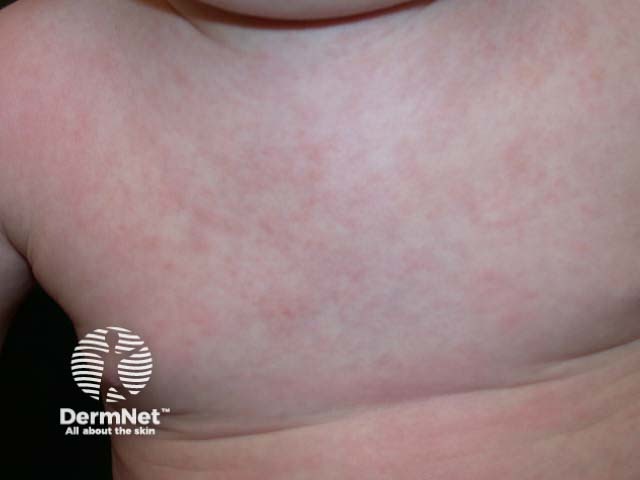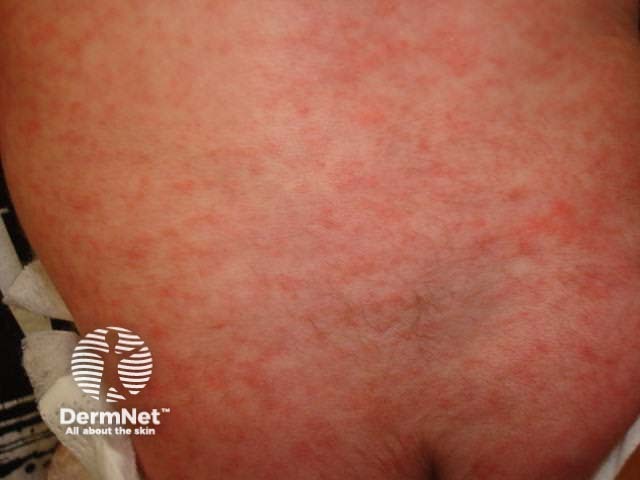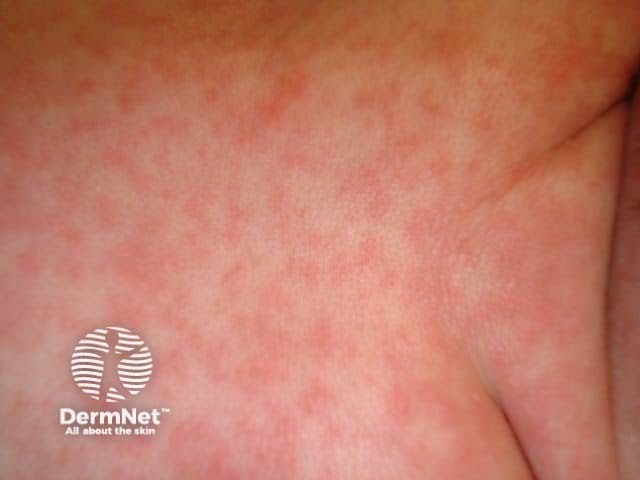Main menu
Common skin conditions

NEWS
Join DermNet PRO
Read more
Quick links
Roseola — extra information
Roseola
Author: Vanessa Ngan, Staff Writer, 2002. Updated by Hon A/Prof Amanda Oakley, September 2015.
Introduction Demographics Spread Signs and symptoms Diagnosis Treatment Complications
What is roseola?
Roseola is a disease caused by the human herpes virus type 6B (HHV-6B) and possibly type 7 (HHV-7). These herpes viruses have only been identified in recent years, and we are still learning about the full range of diseases caused by them.
Roseola is characterised by high fever lasting for 3–5 days, runny nose, irritability and tiredness. As the fever subsides a rash (exanthem) may appear on the face and body.
Roseola is also known by the names roseola infantum and exanthem subitum.



See more images of roseola.
Who gets roseola?
Roseola is most commonly seen in children between 6 months and three years of age. Most children (86%) will have had roseola by the age of 1 year. Roseola is rarely seen in adults, as infection during childhood probably confers lifelong immunity to the disease. Repeat attacks have been known to occur but are not common.
How is roseola spread?
Roseola is spread from person to person via the saliva of asymptomatic family members. The incubation period for roseola is approximately 9–10 days after exposure.
What are the signs and symptoms of roseola?
In many cases of roseola, the child appears well with few or no signs or symptoms. Typical cases are characterised by the following:
- High fever (often up to 40 C) for 3–5 days
- Upper respiratory symptoms such as a sore throat, cough, runny nose or congestion
- Irritability and tiredness
- The rash appears around days 3 to 5, as fever subsides
- Typically small rose-pink or red raised spots (2–5 mm in diameter) that blanch (turn white) when touched
- Some spots may be surrounded by a lighter halo of pale skin
- Mainly affects trunk and rarely spreads to involve the neck, face, arms and legs
- Similar spots occur on soft palate and uvula (Nagayama spots)
- Non-itchy, painless and does not blister
- May fade within a few hours or persist for as long as two days
In some cases, a child may be infected with the virus and never develop the rash. Less commonly, the rash may appear without a preceding fever. In most cases, particularly if fever is low, the child is well. In about 5–15% of young children, high fevers may trigger febrile seizures.
How is roseola diagnosed?
Because roseola is usually mild and self-limiting, diagnosis is usually solely based on the characteristic history and physical examination.
Some laboratories can confirm HHV-6 infection by serology or polymerase chain reaction (PCR).
What is the treatment of roseola?
There is no specific treatment for roseola. The disease is usually mild and self-limiting. Rest, maintaining fluid intake and paracetamol for fever is all that is usually required. No treatment is necessary for the rash, as it does not itch or hurt and fades spontaneously.
What are the complications from roseola?
Complications are rare with roseola in most children. The most common complication is febrile seizures/convulsions that may occur in 5–15% of children. These are triggered by the high fevers of roseola and may be alarming when seen for the first time. Signs of a febrile seizure include:
- Loss of consciousness
- Jerking or twitching movements in the arms, legs or face for 2 to 3 minutes
- Wet or soiled pants in an unconscious, toilet-trained child
- Irritability
These seizures are brief and not dangerous. However, you should have your child examined by a doctor if one happens.
Acute encephalitis, hepatitis, myocarditis, haemophagocytic syndrome and infectious mononucleosis-like illness occur only very rarely.
Reactivation of HHV-6 in immune suppressed patients or in association with drug hypersensitivity syndrome results in fever, rash, pneumonia, hepatitis, bone marrow suppression and encephalitis.
On DermNet
Other websites
- Roseola Infantum in Emergency Medicine — Medscape Reference
